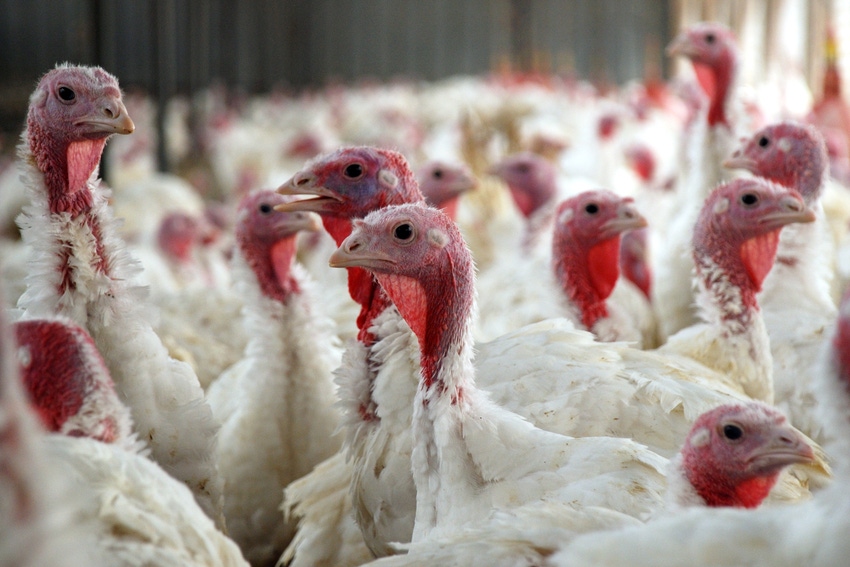HPAI hits two turkey flocks in the Dakotas
Cases mark the first commercial flocks for North and South Dakota in 2023.

USDA’s Animal and Plant Health Inspection Service has reported the confirmation of highly pathogenic avian influenza in two commercial poultry flocks in the Dakotas. The virus was confirmed in a commercial turkey flock of 75,800 birds in Beadle County, S.D. and a commercial turkey flock of 58,500 birds in Dickey County, N.D. The premises have been quarantined and the flocks are being depopulated to prevent the spread of the disease.
“This is the first case of HPAI in poultry in the state this year,” said North Dakota Agriculture Commissioner Doug Goehring. It is also the first 2023 commercial poultry detection for South Dakota.
“Protecting our North Dakota producers, who raise approximately 1 million commercial birds yearly, and our many backyard bird owners is high priority,” Goehring said.
Outside of smaller backyard flocks and wild bird detections, the U.S. had seen a decrease in the number of cases over the past month. However, the latest cases bring the total number of birds affected by the 2022/23 outbreak to 58.79 million.
North Dakota State Veterinarian Dr. Ethan Andress emphasized the importance of restricting access to property, keeping wild birds away from other birds and practicing enhanced biosecurity. “Birds should be kept indoors, especially during the spring and fall migration.”
The primary carriers of avian influenza A are waterfowl, gulls, terns and shorebirds, explained Dr. Gerald Stokka, North Dakota State University Extension veterinarian and livestock stewardship specialist. “Wild birds can be infected without showing symptoms of the infection. While waterfowl are the primary carriers, positive cases are being documented in predatory birds and mammals.”
The best way to reduce the potential for transmission of HPAI is to reduce interaction between wildlife and domestic flocks.
“Wild birds and mammals, such as foxes, coyotes and raccoons, are transmission vectors to your domestic flocks,” says Dr. Stokka.
With wild birds and mammals testing positive for HPAI, hunters, homeowners and landowners should be aware of what steps to take if they see sick or deceased wildlife, advise NDSU Extension specialists.
“One of the first clinical signs of HPAI is sudden, unexplained death,” said Dr. Stokka. “Most HPAI cases are reporting a decline in water and feed consumption prior to the unexplained death.”
Decreased egg production and depression in layers may be another sign that birds are not feeling well. Purple or dry combs, being quieter than normal, frequent laying down and swelling around eyes are other symptoms birds may experience.
“Due to flooding in many parts of North Dakota, there is an increased potential of interaction between the virus and susceptible animals, such as backyard flocks,” said Miranda Meehan, NDSU Extension livestock environmental stewardship specialist. “The HPAI virus can survive in water for extended periods, consequently flooding increases the risk of transmission to domestic birds.”
NDSU Extension specialists have developed tips for reducing transmission of HPAI.
To reduce transmission between wildlife and domestic birds:
If possible, keep poultry housed until the risk for transmission has decreased. Non-lethal methods to deter wildlife are available on the USDA wildlife damage webpage.
Reduce the attractiveness for wildlife to stop at your place by cleaning up litter and spilled feed around your domestic flock housing.
If you come in contact with or handle wildlife, change into clean clothes, wash your hands and disinfect your footwear prior to contact with domestic flocks.
Report sick or deceased wildlife to the state fish and wildlife agency.
If necessary to handle or dispose of carcasses to reduce potential interactions, follow the appropriate procedures.
Restrict use of standing water or ponds that wild birds can access.
To reduce transmission between domestic flocks:
Keep your distance. Restrict access to your property and your flock. Allow contact from people who care for your birds but minimize visitors.
Do not haul disease home. If you have been near other poultry or bird owners, such as at feed stores, clean and disinfect car and truck tires. New birds should be kept separate from your flock for at least 30 days.
Do not borrow disease from your neighbor. Do not share lawn and garden equipment, tools or bird supplies with your neighbor or other flock owners.
“The best defense against HPAI is having a biosecurity plan in place,” said Mary Keena, NDSU Extension livestock environmental management specialist. “It is your job as a flock owner to create a line of separation between your clean flock and the potential unclean issues that wildlife or visitors may bring.”
More information about biosecurity can be found on the USDA Defend the Flock Resource Center webpage.
Sick birds should immediately be reported to a local veterinarian or state veterinarian.
About the Author(s)
You May Also Like





